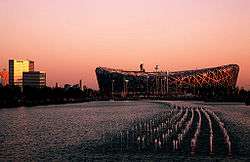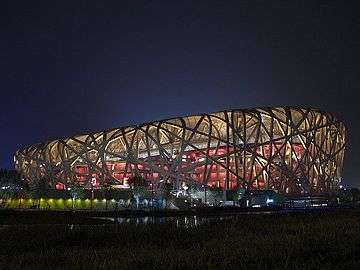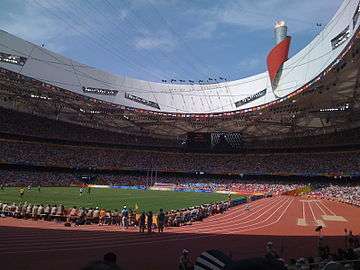Beijing National Stadium
Beijing National Stadium, officially the National Stadium[5] (Chinese: 国家体育场; pinyin: guójiā tǐyùchǎng), also known as the Bird's Nest (鸟巢; niǎocháo), is a stadium in Beijing, The stadium (BNS) was a joint venture among architects Jacques Herzog and Pierre de Meuron of Herzog & de Meuron, project architect Stefan Marbach, artist Ai Weiwei, and CADG which was led by chief architect Li Xinggang.[6] The stadium was designed for use throughout the 2008 Summer Olympics and Paralympics and will be used again in the 2022 Winter Olympics and Paralympics. The stadium is currently mostly unused, after having been unsuccessfully suggested as the permanent headquarters of the Beijing soccer team.[7]
History

Located at the Olympic Green, the stadium cost US$428 million. The design was awarded to a submission from the Swiss architecture firm Herzog & de Meuron in April 2003 after a bidding process that included 13 final submissions. The design, which originated from the study of Chinese ceramics, implemented steel beams in order to hide supports for the retractable roof; giving the stadium the appearance of a bird's nest. Leading Chinese artist Ai Weiwei was the artistic consultant on the project.[8] The retractable roof was later removed from the design after inspiring the stadium's most recognizable aspect. Ground was broken on 24 December 2003 and the stadium officially opened on 28 June 2008. A shopping mall and a hotel are planned to be constructed to increase use of the stadium, which has had trouble attracting events, football and otherwise, after the Olympics.[7]
Bidding
In 2001, before Beijing had been awarded the games, the city held a bidding process to select the best arena design. Multiple requirements including the ability for post-Olympics use, a retractable roof, and low maintenance costs, were required of each design.[9] The entry list was narrowed to thirteen final designs.[10] Of the final thirteen, Li Xinggang of China Architecture Design and Research Group (CADG), said after he placed the model of the "nest" proposal at the exhibition hall and saw the rival entries he thought to himself, "We will win this."[9] The model was approved as the top design by a professional panel and later exhibited to the public. Once again, it was selected as the top design.[9] The "nest scheme" design became official in April 2003.[9]
Design and construction

Why does a Chinese bowl or a Chinese window have this kind of pattern? Maybe the Chinese people like things to appear in this irregular way, but underneath there are very clear rules. The Bird's Nest developed in this way.
— Li Xinggang, head architect of CADG[11]
Beijing National Stadium (BNS) was a joint venture among architects Jacques Herzog and Pierre de Meuron of Herzog & de Meuron, project architect Stefan Marbach, artist Ai Weiwei, and CADG which was led by chief architect Li Xinggang.[6] During their first meeting in 2003, at Basel, the group decided to do something unlike Herzog and de Meuron had traditionally designed. "China wanted to have something new for this very important stadium," Li stated.[6] In an effort to design a stadium that was "porous" while also being "a collective building, a public vessel",[11] the team studied Chinese ceramics.[12] This line of thought brought the team to the "nest scheme".[11] The stadium consists of two independent structures, standing 50 feet apart:[4] a red concrete seating bowl and the outer steel frame around it.[11]
In an attempt to hide steel supports for the retractable roof, required in the bidding process, the team developed the "random-looking additional steel" to blend the supports into the rest of the stadium.[11] Twenty-four trussed columns encase the inner bowl,[13] each one weighing 1,000 tons.[9] Despite the random appearance of the Stadium, each half is nearly symmetrical. [14] After a collapse of a roof at the Charles de Gaulle Airport,[9] Beijing reviewed all major projects. It was decided to eliminate the retractable roof, the original inspiration for the "nest" design,[9] as well as 9,000 seats from the design.[14] The removal of the elements helped to bring the project under the reduced construction budget of $290 million, from an original $500 million.[9] With the removal of the retractable roof, the building was lightened, which helped it stand up to seismic activity; however, the upper section of the roof was altered to protect fans from weather.[14] Enerpac was granted the contract to perform the stage lifting and lowering of the stadium roof as part of the construction process.[15] Due to the stadium's outward appearance, it was nicknamed "The Bird's Nest". The phrase was first used by Herzog & de Meuron, though the pair still believes "there should be many ways of perceiving a building."[11] The use is a compliment Li explained, "In China, a bird's nest is very expensive, something you eat on special occasions."[9]
Ground was broken, at the Olympic Green,[16] for Beijing National Stadium on 24 December 2003.[17] At its height, 17,000 construction workers worked on the stadium.[18] Portraits of 143 migrant workers at the construction site were featured in the book Workers (Gong Ren) by artist Helen Couchman. On 1 January 2008, The Times reported that 10 workers had died throughout construction; despite denial from the Chinese government.[19] However, in a story the following week, Reuters, with the support of the Chinese government, reported that only two workers had died.[18] All 110,000 tons of steel were made in China. On 14 May 2008 the grass field of 7,811 square meters was laid in 24 hours.[20] The field is a modular turf system by GreenTech ITM. Beijing National Stadium officially opened at a ceremony on 28 June 2008.[21]
Features and events

The eastern and western stands of Beijing National Stadium are higher than northern and southern stands, in order to improve sightlines.[22] A 24-hour-per-day rainwater collector is located near the stadium; after water is purified, it is used throughout and around the stadium.[23][24] Pipes placed under the playing surface gather heat in the winter to warm the stadium and coldness in the summer to cool the stadium.[25] The stadium's design originally called for a capacity of 100,000 people; however 9,000 were removed during a simplification of the design. The new total of 91,000 was shaved further when 11,000 temporary seats were removed after the 2008 Olympics; bringing the stadium's capacity to 80,000.[2][26] The farthest seat is 460 feet (140 meters) from center field.[4][25] Temperature and airflow of every surface were optimized to increase ventilation.[25]
Beijing National Stadium hosted the Opening and Closing Ceremonies, athletic events, and football final of the 2008 Summer Olympics from 8 to 24 August 2008.[5] The stadium also hosted the Opening and Closing ceremonies and athletic events of the 2008 Summer Paralympics from 6 to 17 September 2008.[5] Though designed for track & field events of the Olympics, the stadium continues to host sporting events, such as football, afterwards.[14] A shopping mall and a hotel, with rooms overlooking the field, are planned to help increase use after the Olympics.[4] Li stated, "This will become the most important public space in Beijing."[4]
Although ignored by the Chinese media, design consultant Ai Weiwei has voiced his anti-Olympics views and distanced himself from the project, saying, "I've already forgotten about it. I turn down all the demands to have photographs with it," and that it is part of a "pretend smile" of bad taste.[27][28] [29][30]
Football
On its first anniversary, 8 August 2009, the stadium hosted a performance of the opera Turandot, and the 2009 Supercoppa Italiana (Italian Super Cup) final, the traditional curtain raiser to the Italian football league season.[31] In August 2011, the Bird's Nest once again hosted the Supercoppa Italiana, the stadium's second in three years, and also in 2012.
The Beijing Guo’an football club was scheduled to play at the stadium, but later backed out of their agreement, citing the embarrassment of using an 80,000+ seat venue for games that routinely draw only slightly more than 10,000.[7][32]
In July 2010, the stadium hosted a friendly football match between Football League Championship team Birmingham City and Beijing Guoan as a part of Birmingham's pre-season trip to China, homeland of the club's owner Carson Yeung. Birmingham City recorded a 1–0 victory in the game.[33]
Arsenal and Manchester City played each other in the inaugural ‘China Cup’, a one-off match in Beijing’s played on 27 July 2012. Manchester City won the match with a score of 2–0.[34]
The Stadium was also used for the China PR national football team international matches during the 2018 FIFA World Cup qualifiers, however Team Dragon hasn't played any matches since the opening of the stadium.
On 25 July 2016 Manchester City were scheduled to meet Manchester United as part of the 2016 International Champions Cup. However the game was cancelled due to heavy rain soaking the pitch, poor pitch conditions due to fungus and the pitch being relaid with turf.[35] [36]
Other sports events
The stadium hosted the 2009 Race of Champions motor racing carnival.[37] Since 2014, the FIA Formula E Championship motor racing series hosts a round at the Beijing Olympic Park.
On 1 November 2010 the IAAF announced that the 2015 World Championships in Athletics will take place at the Beijing National Stadium.[38]
Concerts
Jackie Chan was the first artist to hold a pop concert at the stadium on 2 April 2009.
American-Chinese pop star Leehom Wang held the first solo pop concert at the stadium on 14 April 2012.[39] Taiwanese band Mayday performed at the stadium for two nights from 29 to 30 April 2012. They were the first band ever to hold two-day concerts at the stadium.
Korean pop artists under S.M. Entertainment including Kangta, BoA, TVXQ, Super Junior (Super Junior-M), Girls' Generation, SHINee, f(x), EXO, Zhang Liyin, and Tasty performed at the stadium for the first time on 19 October 2013 as part of the SMTown Live World Tour III.
In June 2014, DreamWorks' 'How To Train Your Dragon Live Spectacular' opened in a 4,000 seat theatre built on land owned by the Beijing National Stadium.[40]
Cantopop Star Eason Chan is going to hold his last show of the Another Eason's Life at the stadium on 21 and 22 October 2016.
Post-Olympics legacy
On 12 January 2009 the venue's owners announced plans for the stadium to anchor a shopping and entertainment complex. These plans, being developed by operator Citic Group, are projected to take three to five years to achieve. The stadium will also continue to function as a tourist attraction, while hosting sports and entertainment events.[32]
In spite of the lack of significant events, the stadium appears to be quite profitable, drawing some 20,000 to 30,000 people a day at the price of a 50 yuan admission.[41] In 2010 it was used as a snow theme park.[42] The venue costs approximately $9 million to maintain per year.[7][32]
The stadium will be used for the opening and closing ceremonies of 2022 Winter Olympics. It will be the only stadium to date to host both the Summer and Winter Olympics and Paralympics opening ceremonies.[7]
-

The Beijing National Stadium at night during the Summer Olympics
-

Inside of the stadium during the 2008 Summer Olympics
-

Interior view of the stadium
-

2008 Summer Olympics flame
-

Detail of the exterior
-

Architectural detail of the stadium's exterior
-

Beijing National Stadium at night
References
- ↑ "Archived copy". Archived from the original on 4 February 2015. Retrieved 2015-04-10.
- 1 2 "Beijing National Stadium, Olympic Green". East Asia. Arup. Retrieved 28 August 2008.
- ↑ Federal Reserve Bank of Minneapolis Community Development Project. "Consumer Price Index (estimate) 1800–". Federal Reserve Bank of Minneapolis. Retrieved October 21, 2016.
- 1 2 3 4 5 6 Pasternack 2008, pp. 98
- 1 2 3 "The National Stadium". Competition Venues. The Official Website of the Beijing 2008 Olympic Games. Archived from the original on 27 August 2008. Retrieved 27 August 2008.
- 1 2 3 Pasternack 2008, pp. 93
- 1 2 3 4 5 Demick, Barbara (22 February 2009). "Beijing's Olympic building boom becomes a bust". Los Angeles Times. Archived from the original on 25 February 2009. Retrieved 25 February 2009.
- ↑ "China's New Faces: Ai Weiwei". BBC News. 3 March 2005. Retrieved 26 April 2010.
- 1 2 3 4 5 6 7 8 9 Lubow, Arthur (6 May 2006). "The China Syndrome". The New York Times. Archived from the original on 14 May 2013. Retrieved 28 August 2008.
- ↑ "Presentation of Competation". Beijing Municipal Commission of Urban Planning. Archived from the original on 19 June 2008. Retrieved 28 August 2008.
- 1 2 3 4 5 6 Pasternack 2008, pp. 94
- ↑ Pasternack 2008, pp. 93–4
- ↑ Pasternack 2008, pp. 94, 7
- 1 2 3 4 Pasternack 2008, pp. 97
- ↑ "The Engineer". Enerpac Helps the Beijing's 'Bird Nest' to Stand on its own two feet. Retrieved 21 December 2011.
- ↑ Goldberger, Paul (2 June 2008). "Out of the Blocks". The Sky Line. The New Yorker. Archived from the original on 5 October 2008. Retrieved 28 August 2008.
- ↑ "Milestones in the construction of the Bird's Nest". National Stadium. The Official Website of the Beijing 2008 Olympic Games. 28 June 2008. Archived from the original on 24 August 2008. Retrieved 27 August 2008.
- 1 2 Alex Richardson (28 January 2008). "Beijing says 2 died in Bird's Nest construction". Reuters. Retrieved 28 August 2008.
|first1=missing|last1=in Authors list (help) - ↑ "China hushes up Olympic deaths". The Times. London. 20 January 2008. Archived from the original on 24 July 2008. Retrieved 28 August 2008.
- ↑ "Asia's first mobile turf installed in world's biggest 'nest'". National Stadium. The Official Website of the Beijing 2008 Olympic Games. 29 June 2008. Archived from the original on 26 August 2008. Retrieved 28 August 2008.
- ↑ "Newly completed National Stadium welcomes guests". National Stadium. The Official Website of the Beijing 2008 Olympic Games. 28 June 2008. Archived from the original on 26 August 2008. Retrieved 27 August 2008.
- ↑ "Architect: After-Games use is taken into consideration". National Stadium. The Official Website of the Beijing 2008 Olympic Games. 28 June 2008. Archived from the original on 24 August 2008. Retrieved 28 August 2008.
- ↑ "Bird's Nest welcomes rain". National Stadium. The Official Website of the Beijing 2008 Olympic Games. 29 June 2008. Archived from the original on 24 August 2008. Retrieved 28 August 2008.
- ↑ "A green Bird's Nest". National Stadium. The Official Website of the Beijing 2008 Olympic Games. 22 May 2008. Archived from the original on 24 August 2008. Retrieved 28 August 2008.
- 1 2 3 "Bird's Nest: Personalized design furnishes best experience for the audience". National Stadium. The Official Website of the Beijing 2008 Olympic Games. 28 June 2008. Archived from the original on 24 August 2008. Retrieved 28 August 2008.
- ↑ "Boxes inside 'Bird's Nest'". National Stadium. The Official Website of the Beijing 2008 Olympic Games. 29 June 2008. Archived from the original on 24 August 2008. Retrieved 28 August 2008.
- ↑ Cooper, Rafi (6 July 2008). "Cultural revolutionary". The Observer. Archived from the original on 9 July 2008. Retrieved 6 July 2008.
- ↑ "Artist behind Beijing's 'bird's nest' stadium boycotts Olympics". CBC News. 11 August 2007. Archived from the original on 20 June 2008. Retrieved 6 July 2008.
- ↑ "Stadium designer blasts China Olympics". Al Jazeera. 6 July 2008. Archived from the original on 17 August 2008. Retrieved 12 August 2008.
- ↑ "Chinese architect slams Olympic 'pretend smile'". CNN. 13 August 2007. Retrieved 6 July 2008.
- ↑ "Italian Supercoppa 2009 in Beijing". Italian-Calcio Blog. 24 December 2008. Retrieved 24 December 2008.
- 1 2 3 "Beijing's Bird's Nest to anchor shopping complex". ABC News/Associated Press. 30 January 2009. Archived from the original on 14 August 2009. Retrieved 31 January 2009.
- ↑ "Birmingham enjoy friendly win". Italian-Calcio Blog. 21 July 2010.
- ↑ "Archived copy". Archived from the original on 4 March 2012. Retrieved 2012-03-25.
- ↑ "Manchester 'derby' friendly called off in Beijing". Sky Sports. 25 July 2015.
- ↑ http://www.eurosport.com/football/friendly-match-1/2016/manchester-derby-in-china-cancelled-due-to-weather-and-state-of-pitch_sto5697737/story.shtml
- ↑ "Race of Champions moves to Beijing". Autosport.com. Haymarket Publications. 16 April 2009. Archived from the original on 19 April 2009. Retrieved 16 April 2009.
- ↑ "Beijing selected to host 2015 World Championships". www.iaaf.org. IAAF. 20 November 2010. Archived from the original on 24 December 2010. Retrieved 20 November 2010.
- ↑ http://www.china.org.cn/video/2012-04/16/content_25154926.htm
- ↑ http://en.damai.cn/event/tickets_69144/
- ↑ "China tourists twig to Beijing's Bird's Nest". uk.Reuters.com. Reuters UK. 22 April 2009. Retrieved 15 December 2009.
- ↑ "In pictures: Bird's Nest winter wonderland". BBC News. 5 January 2010. Archived from the original on 23 March 2010. Retrieved 26 April 2010.
External links
| Wikimedia Commons has media related to Beijing National Stadium. |
Coordinates: 39°59′30″N 116°23′26″E / 39.99167°N 116.39056°E
| Preceded by Spiros Louis Olympic Stadium Athens |
Summer Olympics Opening and Closing Ceremonies (Beijing National Stadium) 2008 |
Succeeded by Olympic Stadium London |
| Preceded by Spiros Louis Olympic Stadium Athens |
Summer Olympics Football Finals (Beijing National Stadium) 2008 |
Succeeded by Wembley Stadium London |
| Preceded by Spiros Louis Olympic Stadium Athens |
Olympic Athletics competitions Main Venue 2008 |
Succeeded by Olympic Stadium London |
| Preceded by Luzhniki Stadium Moscow |
World Championships in Athletics Main Venue 2015 |
Succeeded by Olympic Stadium London |
| Preceded by Pyeongchang Olympic Stadium Pyeongchang |
Winter Olympics Opening and Closing Ceremonies (Beijing National Stadium) 2022 |
Succeeded by TBA |



